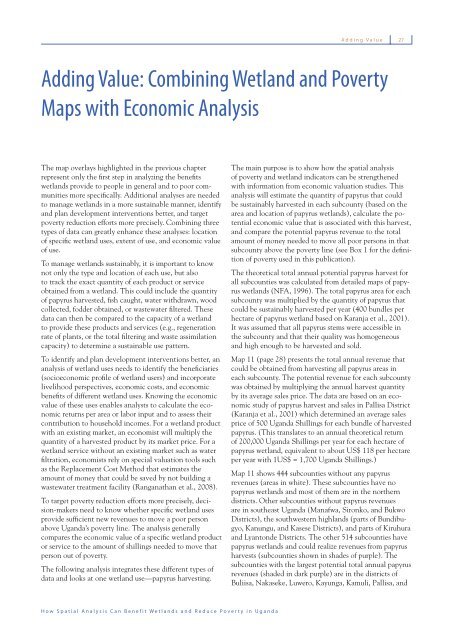Mapping a Better Future - World Resources Institute
Mapping a Better Future - World Resources Institute
Mapping a Better Future - World Resources Institute
Create successful ePaper yourself
Turn your PDF publications into a flip-book with our unique Google optimized e-Paper software.
Adding Value<br />
27<br />
Adding Value: Combining Wetland and Poverty<br />
Maps with Economic Analysis<br />
The map overlays highlighted in the previous chapter<br />
represent only the fi rst step in analyzing the benefi ts<br />
wetlands provide to people in general and to poor communities<br />
more specifi cally. Additional analyses are needed<br />
to manage wetlands in a more sustainable manner, identify<br />
and plan development interventions better, and target<br />
poverty reduction efforts more precisely. Combining three<br />
types of data can greatly enhance these analyses: location<br />
of specifi c wetland uses, extent of use, and economic value<br />
of use.<br />
To manage wetlands sustainably, it is important to know<br />
not only the type and location of each use, but also<br />
to track the exact quantity of each product or service<br />
obtained from a wetland. This could include the quantity<br />
of papyrus harvested, fi sh caught, water withdrawn, wood<br />
collected, fodder obtained, or wastewater fi ltered. These<br />
data can then be compared to the capacity of a wetland<br />
to provide these products and services (e.g., regeneration<br />
rate of plants, or the total fi ltering and waste assimilation<br />
capacity) to determine a sustainable use pattern.<br />
To identify and plan development interventions better, an<br />
analysis of wetland uses needs to identify the benefi ciaries<br />
(socioeconomic profi le of wetland users) and incorporate<br />
livelihood perspectives, economic costs, and economic<br />
benefi ts of different wetland uses. Knowing the economic<br />
value of these uses enables analysts to calculate the economic<br />
returns per area or labor input and to assess their<br />
contribution to household incomes. For a wetland product<br />
with an existing market, an economist will multiply the<br />
quantity of a harvested product by its market price. For a<br />
wetland service without an existing market such as water<br />
fi ltration, economists rely on special valuation tools such<br />
as the Replacement Cost Method that estimates the<br />
amount of money that could be saved by not building a<br />
wastewater treatment facility (Ranganathan et al., 2008).<br />
To target poverty reduction efforts more precisely, decision-makers<br />
need to know whether specifi c wetland uses<br />
provide suffi cient new revenues to move a poor person<br />
above Uganda’s poverty line. The analysis generally<br />
compares the economic value of a specifi c wetland product<br />
or service to the amount of shillings needed to move that<br />
person out of poverty.<br />
The following analysis integrates these different types of<br />
data and looks at one wetland use—papyrus harvesting.<br />
The main purpose is to show how the spatial analysis<br />
of poverty and wetland indicators can be strengthened<br />
with information from economic valuation studies. This<br />
analysis will estimate the quantity of papyrus that could<br />
be sustainably harvested in each subcounty (based on the<br />
area and location of papyrus wetlands), calculate the potential<br />
economic value that is associated with this harvest,<br />
and compare the potential papyrus revenue to the total<br />
amount of money needed to move all poor persons in that<br />
subcounty above the poverty line (see Box 1 for the defi nition<br />
of poverty used in this publication).<br />
The theoretical total annual potential papyrus harvest for<br />
all subcounties was calculated from detailed maps of papyrus<br />
wetlands (NFA, 1996). The total papyrus area for each<br />
subcounty was multiplied by the quantity of papyrus that<br />
could be sustainably harvested per year (400 bundles per<br />
hectare of papyrus wetland based on Karanja et al., 2001).<br />
It was assumed that all papyrus stems were accessible in<br />
the subcounty and that their quality was homogeneous<br />
and high enough to be harvested and sold.<br />
Map 11 (page 28) presents the total annual revenue that<br />
could be obtained from harvesting all papyrus areas in<br />
each subcounty. The potential revenue for each subcounty<br />
was obtained by multiplying the annual harvest quantity<br />
by its average sales price. The data are based on an economic<br />
study of papyrus harvest and sales in Pallisa District<br />
(Karanja et al., 2001) which determined an average sales<br />
price of 500 Uganda Shillings for each bundle of harvested<br />
papyrus. (This translates to an annual theoretical return<br />
of 200,000 Uganda Shillings per year for each hectare of<br />
papyrus wetland, equivalent to about US$ 118 per hectare<br />
per year with 1US$ = 1,700 Uganda Shillings.)<br />
Map 11 shows 444 subcounties without any papyrus<br />
revenues (areas in white). These subcounties have no<br />
papyrus wetlands and most of them are in the northern<br />
districts. Other subcounties without papyrus revenues<br />
are in southeast Uganda (Manafwa, Sironko, and Bukwo<br />
Districts), the southwestern highlands (parts of Bundibugyo,<br />
Kanungu, and Kasese Districts), and parts of Kiruhura<br />
and Lyantonde Districts. The other 514 subcounties have<br />
papyrus wetlands and could realize revenues from papyrus<br />
harvests (subcounties shown in shades of purple). The<br />
subcounties with the largest potential total annual papyrus<br />
revenues (shaded in dark purple) are in the districts of<br />
Buliisa, Nakaseke, Luwero, Kayunga, Kamuli, Pallisa, and<br />
How Spatial Analysis Can Benefit Wetlands and Reduce Poverty in Uganda

















